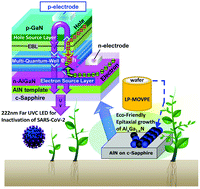Polarization-dependent hole generation in 222 nm-band AlGaN-based Far-UVC LED: a way forward to the epi-growers of MBE and MOCVD
Abstract
Far-ultraviolet-C (Far-UVC) light-emitting-diodes (LEDs) offer a promising technology for the disinfection of surface, air, water, food and airborne disease transmission in occupied spaces, including COVID-19 (SARS-CoV-2) and other viral diseases, when it is meticulously designed, engineered, and applied. Research should continue on both the safety and efficacy of AlGaN-based Far-UVC LEDs, as well as the material choices and device designs to develop highly efficient solid-state UV germicidal irradiation (UVGI) at 222 nm emission to replace toxic low-pressure mercury lamps emitting at 253.7 nm. However, the key issue of hole concentration inside the multi-quantum-wells (MQWs) of AlGaN-based Far-UVC LEDs with high Al-contents is quite critical. Therefore, theoretical studies of AlGaN-based Far-UVC LEDs may suggest sufficient evidence for immediate consideration and implementation for the epitaxial growth of 222 nm-band Far-UVC LED technology during this world-wide health crisis. In this paper, the initial design of the Al-graded p-AlGaN hole source layer (HSL) on the performances of Far-UVC LED was compared with conventional bulk p-AlGaN HSL (non-graded)-based LED devices. For the evaluation of the device's performances, the energy band diagram, internal quantum efficiency (IQE), electrons and holes concentration, radiative recombination rate, and current density vs voltage characteristic were compared. It was found that LEDs at 222 nm emission without using the undoped (ud)-AlGaN final-quantum-barrier (FQB) and only keeping the Al-graded Mg-doped p-AlGaN HSL showed high carrier injection into the MQWs. The variation in the energy band diagram around the p-AlGaN electron-blocking layer (EBL)/p-AlGaN HSL region and p-AlGaN HSL/p-GaN contact-layer (CL) indicates that the introduction of the Al-graded p-AlGaN HSL, as well as the special choice of Al composition at the interfaces, are quite promising for the enhancement of hole injection toward MQWs. The simulation results suggest that the proposed structure of the Al-graded p-AlGaN HSL after omitting the ud-AlGaN FQB structure in the Far-UVC LED is quite useful for achieving high peak efficiency, as well as for suppressing the efficiency droop when compared to the conventional bulk Far-UVC LED. After introducing a new design of 40 nm-thick p-AlGaN HSL in the Far-UVC LED, the radiative recombination rate in the first two quantum-wells of MQWs has been improved up to ∼50%. The enhanced radiative recombination rate is attributed to the enhanced level of electron and hole concentrations by ∼26% and 53%, respectively, in the MQWs. Ultimately, after removing the ud-AlGaN FQB and using 40 nm-thick Al-graded (Al: 100% to 20%) p-AlGaN HSL, the efficiency droop has been remarkably reduced from ∼39% (Bulk-LED) to ∼19% in the new design of Far-UVC LED structure.



 Please wait while we load your content...
Please wait while we load your content...